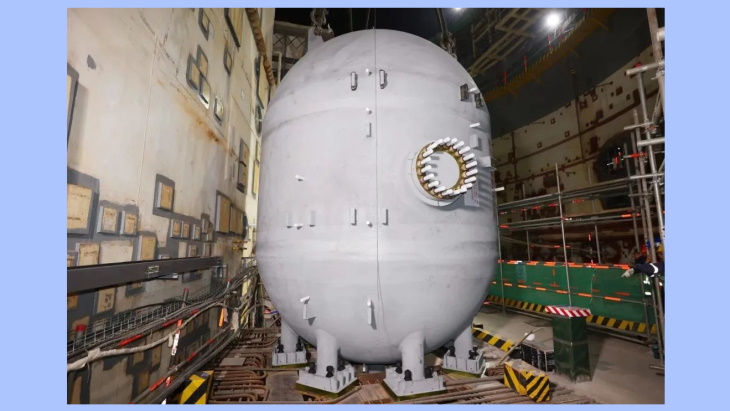Key safety component installed at Sanmen 3
The first of two core makeup tanks has been successfully hoisted into place at unit 3 of the Sanmen nuclear power plant in China's Zhejiang province. The tanks are an important part of the CAP1000 reactor's passive safety system.

The core makeup tank B at Sanmen 3 (Image: SNERDI)
Each CAP1000 unit contains two water replenishment tanks, A and B. They are mainly used to provide boronated water in the event of an accident to ensure the effectiveness of core decay heat removal.
The core water supply tank B was installed at Sanmen 3 on 11 January, the Shanghai Nuclear Engineering Research and Design Institute (SNERDI) announced.
"Due to the complex installation environment of the core water tank, which is surrounded by multiple modular steel beams and structural embedded parts, SNERDI conducted a comprehensive analysis of the hoisting risks in advance and formulated solutions," it said. "Three-dimensional simulation was used to identify and remove interference items on the hoisting path to ensure safe and efficient hoisting work; at the same time, innovate construction technology and milling machines were used to process in blocks and match them with pads of corresponding sizes to effectively solve the flatness of the foundation in place."
The CAP1000 reactor design - the Chinese version of the AP1000 - uses modular construction techniques, enabling large structural modules to be built at factories and then installed at the site. This means that more construction activities can take place at the same time, reducing the time taken to build a plant as well as offering economic and quality control benefits.
The construction of two new reactors at each of the Sanmen, Haiyang and Lufeng sites in China was approved by China's State Council in April 2021. The approvals were for Sanmen units 3 and 4, Haiyang 3 and 4 and units 5 and 6 of the Lufeng plant. The Sanmen and Haiyang plants are already home to two Westinghouse AP1000 units each, and two CAP1000 units were approved for Phase II (units 3 and 4) of each plant.
The CAP1000 reactor design - the Chinese version of the AP1000 - uses modular construction techniques, enabling large structural modules to be built at factories and then installed at the site.
The first safety-related concrete was poured for the nuclear island of Sanmen 3 on 28 June 2022, marking the official start of its construction. The first concrete for that of unit 4 was poured on 22 March 2023.
Researched and written by World Nuclear News
- China Institute of Atomic Energy
- Nuclear Power Institute of China
- Southwestern Institute of Physics
- China Nuclear Power Operation Technology Corporation, Ltd.
- China Nuclear Power Engineering Co., Ltd.
- China Institute for Radiation Protection
- Beijing Research Institute of Uranium Geology (BRIUG)
- China Institute of Nuclear Industry Strategy (CINIS)
- China Nuclear Mining Science and Technology Corporation


